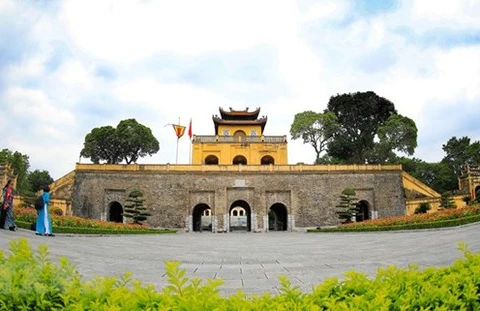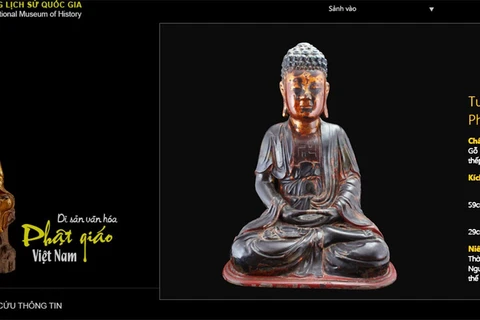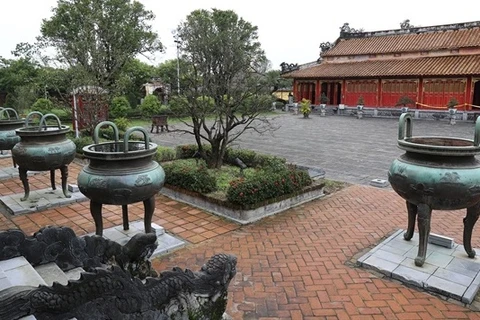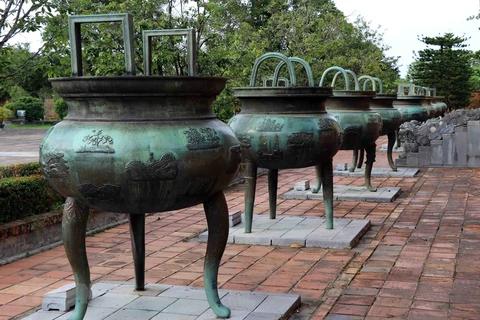 Chairman of the Vietnam Archaeological Association Tong Trung Tin points at an excavation site (Photo: VietnamPlus)
Chairman of the Vietnam Archaeological Association Tong Trung Tin points at an excavation site (Photo: VietnamPlus) Hanoi (VNA) – Archaeologists on April 22 announced many vestiges they had found at an excavation area of nearly 1,000 square metres in the northeast of the Kinh Thien Palace relic site, part of the Thang Long Imperial Citadel in Hanoi.
The most outstanding discoveries include a deepest-ever well uncovered by archaeologists, a basin with a 1.2m-wide mouth from the Tran Dynasty, and a twin grave built from bricks are among the most notable discoveries this time.
A number of valuable discoveries
Dr Tong Trung Tin, Chairman of the Vietnam Archaeological Association, said the excavation team, including members from the Thang Long - Hanoi Heritage Conservation Centre and the Institute of Archaeology, found five layers of relics dating back to the dynasties of Nguyen (1802 - 1945), “Le trung hung” - Revival Le (1533 - 1789), “Le so” - Early Le (1428 - 1527), Tran (1225 - 1400), and Ly (1010 - 1225), along with the pre-Thang Long period.
 Dr Tong Trung Tin, Chairman of the Vietnam Archaeological Association, gives introduction of a newly-found well to visiting experts (Photo: VietnamPlus)
Dr Tong Trung Tin, Chairman of the Vietnam Archaeological Association, gives introduction of a newly-found well to visiting experts (Photo: VietnamPlus) At a depth of 1.3 metres from the current ground surface, they discovered a well that is almost seven metres deep - the deepest-ever well found so far, Tin affirmed.
He said since Director of the then Centre of Imperial Citadel Studies Bui Minh Tri and he unearthed a 5.9m-deep well in 1952, this is the first time Tri has found a well as deep as this one. This well is even deeper than the average depth of the Red River.
The well, about 3 metres in diameter, was made from stone slabs and fortified by multiple layers of stones and pebbles, giving it a good look.
That was a popular construction method of relics from the Tran Dynasty in the 13th - 14th century, he said, noting that they guess this well was built to serve Can Chanh Palace, where the king worked and met his mandarins every day.
Tin added that scientists also discovered several “Canh Thinh thong bao” coins. “Canh Thinh” was the reign title from 1793 to 1801 of King Nguyen Quang Toan (1783 - 1802), son of King Quang Trung - Nguyen Hue.
The presence of “Canh Thinh thong bao” coins in the bottom of the well indicates that the well was not blocked at that time, according to him.
Also at this site, archaeologists unearthed a large basin that is 1.2 metres in diameter and 55 centimetres in height and decorated with flower patterns around its mouth. It remains almost intact and dates back to the Tran Dynasty. This could be the biggest terracotta basin discovered so far.
Meanwhile, vestiges of many different periods have been uncovered at 4.8 metres underground, and the biggest discovery is two brick graves from the pre-Thang Long period.
The two graves are parallel to each other with their heads turning to the northeast. The excavation team also found three ceramic jars and some bronze coins at the grave site. However, it is regretable that the graves have only their walls and bottoms left since the site was later traversed by a small brook.
As this site was the centre of the Thang Long Imperial Citadel, so these graves could have been built before the citadel was built. Besides, their depth indicates that people could have resided here since the fourth - sixth century, Tin added.
Value of Imperial Citadel further clarified
Assoc. Prof. Dr Bui Minh Tri, Director of the Institute of Imperial Citadel Studies, said the excavation in 2020 and 2021 has revealed much new information, helping to further clarify the value of the Thang Long Imperial Citadel.
He held that it is very rare in the world that a capital city has still managed to preserve a complex of relic sites dating to different but continuous periods like this, which is an outstanding feature contributing to the great value and uniqueness of the Thang Long Imperial Citadel - a world heritage site recognised by UNESCO.
Meanwhile, Tin said they estimate only about 7 percent of the citadel relic site has been unearthed, and more study is needed to recreate part of citadel.
Scientists hope to succeed in drawing the entire citadel in different periods in the near future, he added./.
 A round-shape structure that is 5 metres wide and dates back to the Tran Dynasty (Photo: VietnamPlus)
A round-shape structure that is 5 metres wide and dates back to the Tran Dynasty (Photo: VietnamPlus)  A terracotta basin with a mouth 1.2 metres wide in diameter from the Tran Dynasty (Photo: VietnamPlus)
A terracotta basin with a mouth 1.2 metres wide in diameter from the Tran Dynasty (Photo: VietnamPlus) 

































